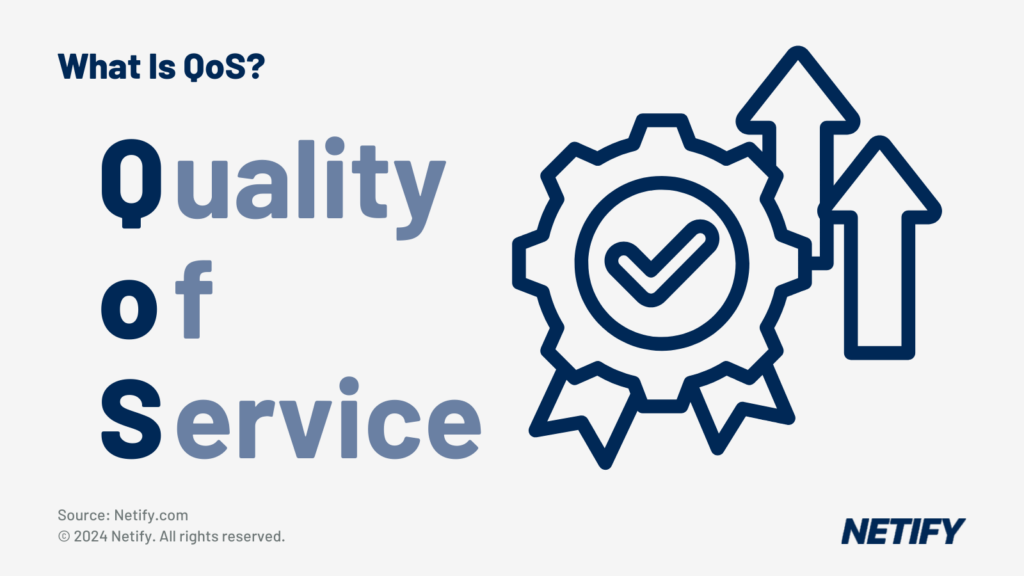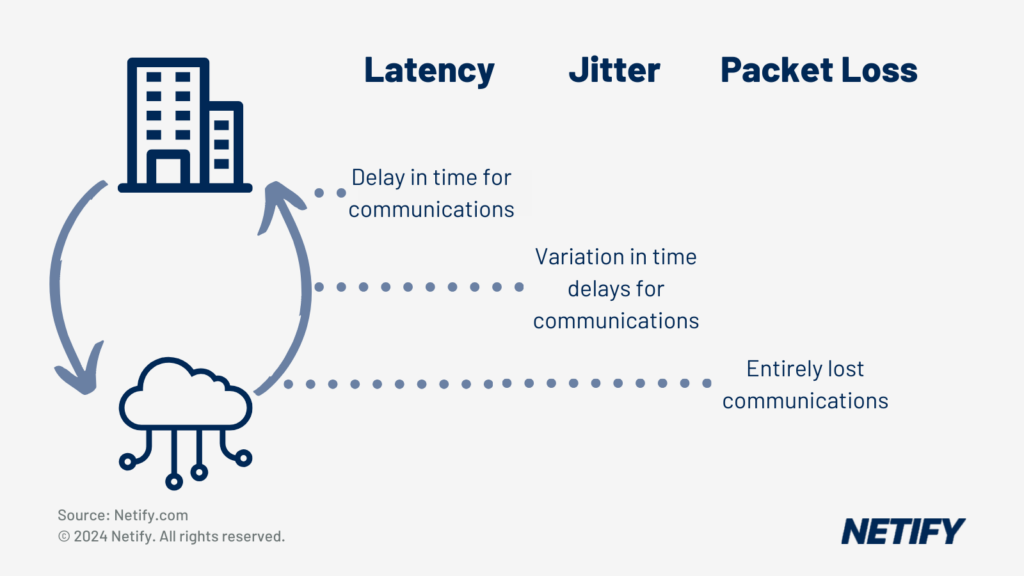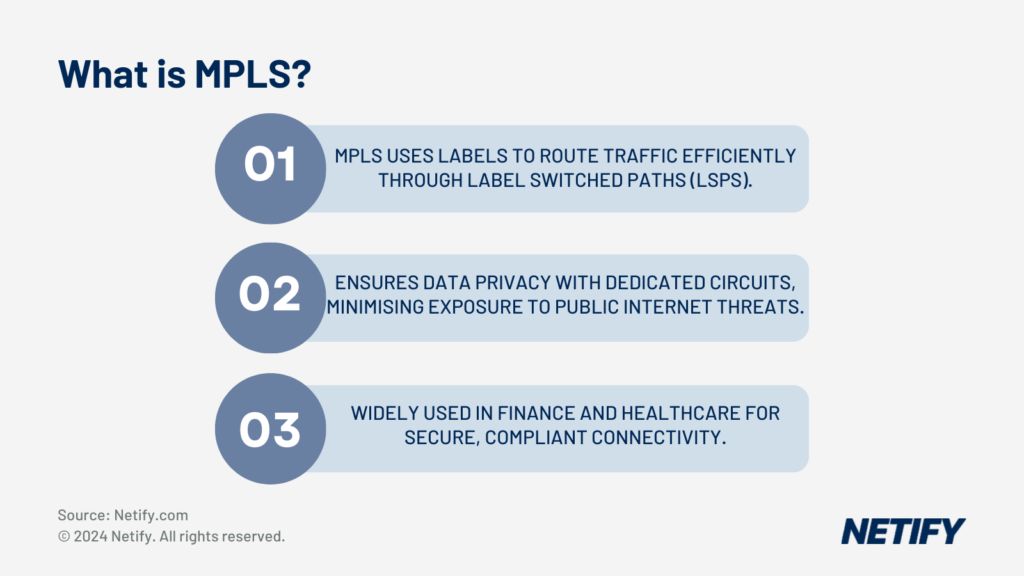What is QoS (Quality of Service)
| Quality of Service (QoS) allows businesses to define types of network traffic to be prioritised by SD-WAN. |

Quality of Service (QoS) is a set of techniques to manage traffic across a network in order to optimise preferential performance. These optimisations vary between solutions but may prioritise specific network traffic, critical applications or services, allowing networks to increase reliability and maintain consistent performance. Techniques for QoS typically include traffic classification, queuing and scheduling in order to improve network efficiency. By increasing network efficiency, QoS reduces congestion and latency, whilst the overall user experience (UX) of the network is improved.
Quality of Service can be used to address many common problems with a network, such as latency, traffic prioritisation and the real-time allocation of sufficient bandwidth to key applications. Network stability can be achieved through predictable performance by: minimising jitter, latency and packet loss, to increase the integrity of the network. QoS combats these by implementing features such as packet loss error correction, dynamic allocation of resources and queuing/shaping to prevent interruptions.
As both MPLS and SD-WAN aim to provide improved networking performance and user experience, QoS capabilities, whilst differing between solutions, is a key component to each technology.
Whilst MPLS QoS uses Service-Level Agreements (SLAs) from service providers to set a minimum threshold for bandwidth, speed, latency and connection quality, SD-WAN, being self-managed/co-managed focuses on Quality of Experience (QoE) based on available network links.
Core Principles of QoS
To ensure good QoS, network administrators must minimise the latency, jitter and packet loss within a network:

Latency refers to the time delay experienced for a packet to travel from source to target across a network. These are often caused by distance, the number of network hops, congestion or processing delays.
Jitter refers to the variation in latency for packets to travel from source to target across a network. These are often caused by network congestion, improper queuing or configuration errors.
Packet loss refers to when packets fail to reach a target when transported across a network. Often packets are dropped due to factors such as: network congestion, hardware issues, software bugs or exceeding bandwidth limits.
An additional consideration is that QoS to improve latency and jitter is typically only a major concern within global networks. This is due to in-country traffic performance over internet being reliable and not such a concern. Latency and jitter do however become more problematic when considering longer distance network coverage.
QoS in MPLS Networks
MPLS works by using routing techniques to transfer data from one node to the next based on short path labels. This avoids complex lookups in a routing table, providing unified data-carrying to both circuit-based and packet-switching clients.
MPLS improved on older router-based networking methods. Previously, all traffic was treated with equal importance, whereas with MPLS there was an introduction of separated bandwidths and communication links in order to designate static routes for critical applications, enabling prioritisation for QoS. MPLS therefore provided networks with greater granularity and scalability, as crucial traffic could be ensured service despite scaling of the network.
MPLS enables end-to-end QoS via packet switching:
- Label Switched Paths. These are unidirectional tunnels that pair routers within a network. Packets are assigned Forward Equivalence Classes (FECs) and routed down pre-determined Label Switched Paths based on each packets label.
- MPLS labels contain a 3-bit field to signify the priority of the packet. These labels are referred to either as EXP (Experimental) or traffic class and defined which path to take within the MPLS network.
- DiffServe-aware traffic engineering (DS-TE) allows for the creation of separate Label Switched Paths for different classes, providing a dedicated bandwidth that is reserved for high priority packets.
In the event of a link or node failure, MPLS has inbuilt traffic restoration, allowing for quick re-routing (<50ms) of affected traffic.
Some MPLS vendors have built a core MPLS network to help improve Quality of Service factors such as latency and jitter. This there improves global network connections by enhancing quality of service for long distance connections.
Evolution of SD-WAN and Its Impact on QoS
Software-Defined Wide-Area Network (SD-WAN) solutions use software to centralise management and improve performance, with policy settings used defined to set traffic priorities.
By decoupling the control plane from the data plane, SD-WAN allows for real-time dynamic routing of traffic over multiple network links, based on network telemetry data. This can be used to reduce network congestion, maximise application performance and therefore manage SD-WAN Quality of Service.
By monitoring traffic for latency, jitter and packet loss, SD-WAN can actively choose the optimal path for traffic, providing the most efficient network resource usage, whilst adapting to changing network conditions. Furthermore, SD-WAN also includes Quality of Service features such as traffic shaping and prioritisation, providing a complete solution for increased flexibility, reliability and cost-effective QoS.
Comparative Analysis: SD-WAN vs. MPLS QoS Capabilities
MPLS and SD-WAN differ as MPLS uses static label-based routing, whereas SD-WAN uses dynamic software-defined policies for routing.

For an MPLS system, it defines packets into classes, prioritising certain traffic types.
MPLS has the ability through SLAs to guarantee performance and enables end-to-end Quality of Service.
SD-WAN implements QoS policies in order to prioritise traffic through its software-based management. This gives SD-WAN granular control over application traffic, but actual performance depends on underlying transport. Despite being able to adapt routing dynamically in real-time, this dependence on underlying transport means that SD-WAN cannot provide end-to-end Quality of Service.
This is because SD-WAN lacks the SLA guarantees that MPLS possesses, which is an especially important consideration when reviewing latency-sensitive applications.
MPLS is also considered more secure than SD-WAN because it establishes isolated private networks for each customer, segregating one customer's traffic from others and therefore means that MPLS may be more applicable in sectors requiring closed-loop communications for regulatory compliance.
Advanced QoS Features in SD-WAN
Within SD-WAN, the application-aware routing capabilities enhance Quality of Service.
The SD-WAN controller identifies applications based on IP, port, protocol and deep packet inspection in order to select the optimal routing for the applications priority within the network. This provides more granular control and dynamic Quality of Service when compared to MPLS. As SD-WAN uses remote management and automated path selection, this also reduces complexity of QoS management than the manually defined static routes in MPLS.
SD-WAN provides support for multiple classifications of traffic, with different policies applied for each class and the ability for traffic to automatically be classified based on application type, IP, header fields or DSCP values. The classes are mapped onto a hardware queue with defined bandwidth allocations, scheduling and drop policies, therefore allowing for preferential treatment of critical applications.
By utilising centralised policies, SD-WAN enables the ability to easily make changes to Quality of Service features. Localised data policies on WAN edge can also be implemented for queuing and shaping in an interface specific manner.
Challenges and Considerations in Implementing QoS in SD-WAN
With SD-WAN it is difficult to ensure consistent QoS over the internet, as unlike MPLS which is end-to-end, SD-WAN uses internet-based links which are best-effort and performance varies dependent on current conditions. The introduction of Forward Error Correction (FEC), packet duplication and dynamic path routing help improve the QoS of SD-WAN however do not guarantee consistent QoS. SD-WAN is reliant on the performance and integration of both overlay and underlay together in order to achieve better QoS, but given the reliance on underlay physical WAN links, this affects SD-WAN QoS and prevents it from being considered end-end.
One notable consideration is that organisations can adopt a hybrid approach, utilising MPLS for critical applications that required a guaranteed QoS and SD-WAN for lower priority traffic. This harnesses the ability of both technologies, providing further enhanced network performance. However this does increase the network complexity which may negatively affect network administrator workload.
Future Trends in QoS Management
Next-Generation SD-WAN implementations provide network administrators with even more granular visibility and control over apps, improving overall QoS management. These implementations identify thousands of apps and dynamic route traffic based on priority in real-time.
SD-WAN solutions are providing a tighter integration between SD-WAN and the cloud, with Software-as-a-Service (SaaS) applications applying QoS policies across an extended range of the network, from edge to cloud.
Artificial Intelligence (AI) is being used for predictive optimisation and analysis of historical data, optimising routing of traffic for improved QoS. AI is also being used for delegating granular application specific QoS policies, dynamically generating and enforcing policies based on learning the unique requirements of each application.
The addition of Shapley Additive Explanations (SHAP) to SD-WAN solutions is also be utilised to explain AI and machine learning driven QoS decisions so that there is more transparency and provides network administrators justifications behind automated policies.
Conclusion
Quality of Service is essential in network managements for network performance. By minimising traffic latency, jitter and packet loss to optimise critical application performance, networks boost overall user experience and increase the reliability of the network.
Traditional MPLS networks prioritise traffic using statically defined classes and label switching techniques, whilst providing end-to-end QoS.
SD-WAN networks, whilst unable to provide end-to-end QoS due to underlay limitations, prioritise traffic using dynamic routing policies over multiple links, using real-time data and analytics to maximise efficiency.
Dependent on the QoS requirements of the network, IT decision makers should carefully review the benefits of each MPLS and SD-WAN to determine which implementation is more applicable. MPLS offers reliable performance with dedicated links and service-level agreements for high-priority traffic, making it suitable for latency-sensitive applications (such as VoIP). Alternatively, SD-WAN provides more flexibility, cost-effectiveness, and easier cloud integration, which can be considered more ideal for distributed workplaces and application environments. A hybrid approach may leverage both MPLS and SD-WAN, combining their strengths to meet comprehensive QoS requirements, balancing performance, cost, and growth considerations.